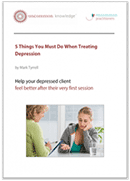Learn how to overcome limitations
Discover how limitations are created and what you can do to break through them
We human beings are social creatures. This means that, to a greater or lesser degree, we learn from others what to think, how to be and what to expect. We'll often look to what other people believe to ascertain whether something is possible or impossible. Even if we consciously think we have made up our own minds by ourselves, we may well have been affected by prevailing popular opinion without being aware of how it has influenced our beliefs. What people around us commonly believe is important. And more important to some people than others.
This isn't to say that we can't really be independent individuals at all, but our perceptions as to what is doable or possible are more often shaped by what the crowd thinks than we might credit.
This has its positive aspects. Quite often the majority view is 'right', so you don't have to waste too much time. For example, most people believe it's wise to take malaria tablets before travelling to malaria-infested regions of the world. While we could question the basis of this belief, it may well be wiser to err on the side of the collective view. But always accepting common belief as to what can or can't be done can restrict our range of achievement in unnecessarily - and painfully - limiting ways.
It often takes only one person to demonstrate that what was previously thought impossible is actually possible. And when this person comes along and does the so-called impossible suddenly, all those people who had limited themselves before on account of the widely held view that it couldn't be done now find that they can do it too.
This is known as 'the Bannister effect'.
It used to be widely thought that it was not humanly possible to run a mile in under four minutes. Many talented athletes had tried, had come amazingly close, but ultimately failed to break that magic four minute marker. The human body, it was thought, just couldn't do it. But on 6 May 1954, in front of 3,000 people, a young doctor called Roger Bannister did the 'impossible'. He ran the mile in three minutes and 59.4 seconds. As soon as the crowd heard the word 'three' announced, they went wild. But here's the even more interesting bit. Roger Bannister didn't just break through a physical barrier - he smashed through a psychological one as well. In the year afterBannister proved the impossible possible, no less than 37 runners also ran a mile in under four minutes, and in the year after that another 300 did the same. Why? Did they all suddenly have better coaching, more targeted training schedules, improved diet, better running techniques? No. The difference was that all these people, who could have done it before but didn't know it, now knew it was achievable. And so they did it.
At this current time no one has run a marathon in less than two hours and many say it's not possible. No doubt when someone breaks that barrier, many more will follow. But why do we wait? To overcome your own limitations, sometimes you have to be your own Roger Bannister. Sometimes you have to smash the perceived limitations.
We all age, but different people age differently and it's not all down to our genes. Our attitudes to aging affect how we ourselves age. Young people's conceptions of what it means to be old will affect their own later health and vigour when they themselves eventually become older.
A study carried out by the University of Texas found that people who were upbeat and positive about their lives showed significantly less evidence of frailty (or other signs of aging commonly assumed to be inevitable) than those who saw aging as an inevitable decline. Another piece of research showed that there was a direct correlation between how positively or negatively young people viewed the elderly and how they themselves would experience aging. But even more startling research has shown that attitude can make us feel - and even look - twenty years younger.
Some years ago Harvard psychologist Ellen Langer conducted a mind-blowing study with a group of elderly men. Langer put the men in an isolated old New England hotel that had been fitted out in the style of a hotel from two decades before, so that every visible sign indicated twenty years earlier. The men - in their late 70s and early 80s - were told not to reminisce about the past, but to actually act as if they had travelled back in time. The idea was to see if altering the men's mindset about their own age might have any measurable physical result. The results were amazing and have huge implications for how we all live.
After just one week, the old men in the experimental group (compared with controls of the same age) had more joint flexibility, increased dexterity and less arthritis in their hands. Their mental acuity had improved and they stood and walked better.
Outsiders who were shown photographs of the men judged them to be significantly younger than the men in the control group. In other words, the aging process had in some measure been reversed - just by focussing on their psychological state.
What is a stereotype other than a 'belief'? If you see yourself as a stereotypical 'old person', then this can be an extremely limiting belief.
If we're not careful, we can mindlessly accept negative cultural cues about disease and old age, and these cues can come to shape our self-concepts, our behaviour, our health itself and - of course - what we consider possible or impossible. If we can shake loose from the negative clichés that dominate our thinking about health, we can 'mindfully' open ourselves to possibilities for more productive lives even into old age.
Consider another of Langer's 'mindset' studies. This one used an ordinary optometrist's eye chart. That's the chart with the huge E on top, and descending lines of smaller and smaller letters that eventually become unreadable. Langer and her colleagues wondered: what if we reversed it? The regular chart creates the expectation that at some point you will be unable to read the text. Would turning the chart upside down reverse that expectation, so that people would expect the letters to become readable? That's exactly what they found. The subjects still couldn't read the tiniest letters, but when they were expecting the letters to get more legible, they were able to read smaller letters than they could have normally. Their expectation - their mindset - improved their actual vision.
Most people try to dress appropriately for their age, and what they wear in effect becomes a cue for determining someone's age - and also triggers the ingrained attitudes of the spectator around age. How we dress sends signals to others but also to ourselves as to how old we are, or what we are like generally.
But what if this dress cue disappeared? Langer decided to study people who routinely wear uniforms as part of their work life, and compare them with people who dress in ordinary clothes. She discovered that people who wear uniforms had fewer days off work owing to illness or injury, fewer doctors' visits and hospitalizations, and fewer chronic diseases - even though they all had the same socioeconomic status. That's because they were not constantly reminded of their own aging by their fashion choices. The health differences were even more exaggerated when Langer looked at affluent people: presumably having the means to buy even more clothes provides a steady stream of new aging cues, which wealthy people internalize as unhealthy attitudes and expectations.
We are surrounded every day by subtle signals that aging is an undesirable period of decline. Similar signals lock all of us - regardless of age - into pigeonholes for all sorts of things. If we think we are smart or stupid, these beliefs in and of themselves will affect how smart or stupid we actually are.
Teachers who are told that children with learning difficulties are, in fact, extremely gifted then treat these children as if they were gifted. This attitude subtly extends from teacher to children and actually makes the children more able. I'm not suggesting that attitude is all there is to it. Some people will clearly never run a sub four-minute mile. But in the early 1950s hundreds of men who were quite physically capable of doing it didn't do it because they had swallowed the cultural belief that it was impossible.
So what are the implications of all this?
It means it's vitally important to be aware of and to think carefully about the labels you've applied to yourself, because those labels could be limiting your life inappropriately - and unnecessarily. In particular, it's important to check out those self-assessments (which may not have come from you at all) which assert "People like me can't do X" or "I am not the sort of person who can do Y".
If you feel something is impossible for you, apply the three step limitation buster:
- sit down, close your eyes, take a few deep breaths to relax
- hypnotically imagine seeing lots of people doing it
- vividly visualize yourself doing it too
Hypnosis is a wonderful way of instilling the belief that something is achievable before you achieve it.
And finally I'm reminded of the words of Henry Ford: "Whether you think you can or you think you can't, you are usually right."

Help depressed clients quickly: Free eBook
Get '5 Things You Must Do When Treating Depressed Clients' free when you subscribe for email updates.

Return to Uncommon Hypnosis Master Series
blog comments powered by Disqus




 PDF
PDF Email
Email Print
Print

